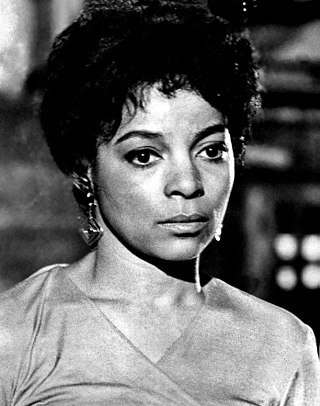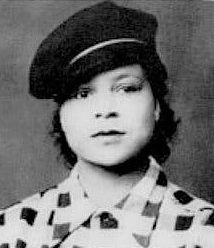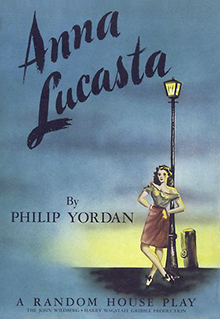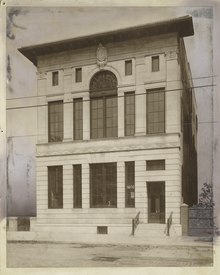
Raiford Chatman "Ossie" Davis was an American actor, director, writer, and activist. He was married to Ruby Dee, with whom he frequently performed, until his death. He received numerous accolades including a Grammy Award and a Writers Guild of America Award as well as nominations for five Emmy Awards, a Golden Globe Award, and Tony Award. Davis was inducted into the American Theater Hall of Fame in 1994 and received the National Medal of Arts in 1995, Kennedy Center Honors in 2004

Ruby Dee was an American actress, poet, playwright, screenwriter, journalist, and civil rights activist. Dee was married to Ossie Davis, with whom she frequently performed until his death in 2005. She received numerous accolades including two Emmy Awards, a Grammy Award, a Obie Award and a Drama Desk Award as well as nominations for an Academy Award. She was honored with the National Medal of Arts in 1995, the Screen Actors Guild Life Achievement Award in 2000, and the Kennedy Center Honors in 2004.

Theater in the United States is part of the old European theatrical tradition and has been heavily influenced by the British theater. The central hub of the American theater scene is Manhattan, with its divisions of Broadway, Off-Broadway, and Off-Off-Broadway. Many movie and television stars have gotten their big break working in New York productions. Outside New York, many cities have professional regional or resident theater companies that produce their own seasons, with some works being produced regionally with hopes of eventually moving to New York. U.S. theater also has an active community theater culture, which relies mainly on local volunteers who may not be actively pursuing a theatrical career.
Alice Childress was an American novelist, playwright, and actress, acknowledged as "the only African-American woman to have written, produced, and published plays for four decades." Childress described her work as trying to portray the have-nots in a have society, saying: "My writing attempts to interpret the 'ordinary' because they are not ordinary. Each human is uniquely different. Like snowflakes, the human pattern is never cast twice. We are uncommonly and marvellously intricate in thought and action, our problems are most complex and, too often, silently borne." Childress became involved in social causes, and formed an off-Broadway union for actors.

Frederick O'Neal was an American actor, theater producer and television director. He founded the American Negro Theater, the British Negro Theatre, and was the first African-American president of the Actors' Equity Association. He was also known for his work behind the scenes as a revolutionary trade unionist.

Gertrude Hadley Jeannette was an American playwright and film and stage actress. She is also known for being the first woman to work as a licensed taxi driver in New York City, which she began doing in 1942. Despite being blacklisted during the Red Scare in the 1950s, she wrote five plays and founded the H.A.D.L.E.Y. Players in Harlem, New York, remaining active in mentoring African-American actors in New York City. In the 1960s and 1970s she appeared in Broadway productions such as The Long Dream, Nobody Loves an Albatross, The Amen Corner, The Skin of Our Teeth and Vieux Carré. She also appeared in films such as Cotton Comes to Harlem in 1969, Shaft in 1971, and Black Girl in 1972. She acted into her 80s and retired from directing theater at the age of 98.

Eulalie Spence was a writer, teacher, director, actress and playwright from the British West Indies. She was an influential member of the Harlem Renaissance, writing fourteen plays, at least five of which were published. Spence, who described herself as a "folk dramatist" who made plays for fun and entertainment, was considered one of the most experienced female playwrights before the 1950s, and received more recognition than other black playwrights of the Harlem Renaissance period, winning several competitions. She presented several plays with W.E.B. Du Bois' Krigwa Players, of which she was a member from 1926 to 1928. Spence was also a mentor to theatrical producer Joseph Papp, founder of The Public Theater and the accompanying festival currently known as Shakespeare in the Park.

Osceola Marie Adams, known professionally by the stage name Osceola Archer, was one of the first Black actresses to appear on Broadway in Between Two Worlds in 1934. Speaking of Adams' decade-long role as director of some three dozen productions at the Putnam County Playhouse, actor Carl Harms noted she was likely also the first African-American director of summer stock.

Alvin Childress was an American actor, who is best known for playing the cabdriver Amos Jones in the 1950s television comedy series Amos 'n' Andy.

Hilda Simms was an American stage actress, best known for her starring role on Broadway in Anna Lucasta.

J. E. Franklin is an American playwright, best known for her play Black Girl, which was broadcast on public television in 1969, staged Off-Broadway in 1971, and made into a feature film in 1972. She has written and adapted plays for television, theater, and film.
Dick Campbell, born Cornelius Coleridge Campbell, was a key figure in black theater during the Harlem Renaissance. While a successful performer in his own right, Campbell is best known as a tireless advocate for black actors in general. As a theater producer and director, he helped launch the careers of several black theater artists, including Ossie Davis, Frederick O'Neal, Loften Mitchell, Helen Martin, and Abram Hill.
A number of theatre companies are associated with the Harlem Renaissance.

Anna Lucasta is a 1944 American play by Philip Yordan. Inspired by Eugene O'Neill's Anna Christie, the play was originally written about a Polish American family. The American Negro Theatre director Abram Hill and director Harry Wagstaff Gribble adapted the script for an all African American cast, and presented the first performance on June 16, 1944. The play moved from Harlem to Broadway's Mansfield Theatre, running August 30, 1944 – November 30, 1946. The Broadway cast included Hilda Simms, Canada Lee, and Alice Childress.
New Heritage Theatre Group (NHTG) is the oldest Black nonprofit theater company in New York City, established in 1964. Through its multiple divisions: IMPACT Repertory Theatre, The Roger Furman Reading Series, and New Heritage Films, New Heritage gives training, exposure, and experience to new and emerging artists, playwrights, directors and technicians of color. New Heritage was founded by the late Roger Furman and is currently headed by Executive Producer Voza Rivers and Executive Artistic Director Jamal Joseph. NHTG presentations capture the historical, social, and political experiences of Black and Latino descendants in America and abroad.
Abram Hill, also known as Ab Hill, was an American playwright, author of On Strivers Row, Walk Hard, Talk Loud and several other plays; and a principal figure in the development of black theatre from Atlanta, Georgia.

Billie Allen was an American actress, theater director, dancer and entertainer. Allen was one of the first black actors and performers to appear on television and stage in the United States, at a time when those venues were largely closed to African Americans. During the 1950s, Allen became one of the first black entertainers to have a recurring role on network television when she was cast as a WAC on staff on the CBS army base comedy The Phil Silvers Show, from 1955 to 1959. She was one of the first African Americans to appear on television commercials in the U.S. She was also one of the earliest African-American actors on daytime soap operas as she appeared in the mid-1950s as the character Ada Chandler on the popular daytime soap opera The Edge of Night. Allen was also known for her work on Broadway and off-Broadway.
Stella Holt was an American theater producer. She served as managing director of the off-Broadway Greenwich Mews Theater in New York City for 15 years.
Georgia Burke was an American actress who had performed on television, radio, and Broadway theatre between the 1930s and the 1960s. In 1934 Burke made her debut in Broadway in They Shall Not Die, and in 1944 she won a Donaldson Award as the third choice for Best Supporting Actress in Edward Chodorov's play, Decision. Burke had performed in the 1952 U.S. State Department-sponsored international production of Porgy and Bess and had taken a role as a nurse in the radio program When a Girl Marries, which had been broadcast for 18 years. She had also performed in the 1944 Broadway production of Anna Lucasta and its second film counterpart in 1958.

Freedom was a monthly newspaper focused on African-American issues published from 1950 to 1955. The publication was associated primarily with the internationally renowned singer, actor and then officially disfavored activist Paul Robeson, whose column, with his photograph, ran on most of its front pages. Freedom's motto was: "Where one is enslaved, all are in chains!" The newspaper has been described as "the most visible African American Left cultural institution during the early 1950s." In another characterization, "Freedom paper was basically an attempt by a small group of black activists, most of them Communists, to provide Robeson with a base in Harlem and a means of reaching his public... The paper offered more coverage of the labor movement than nearly any other publication, particularly of the left-led unions that were expelled from the CIO in the late 1940s... [It] encouraged its African American readership to identify its struggles with anti-colonial movements in Africa, Asia, and the Caribbean. Freedom gave extensive publicity to... the struggle against apartheid."

























